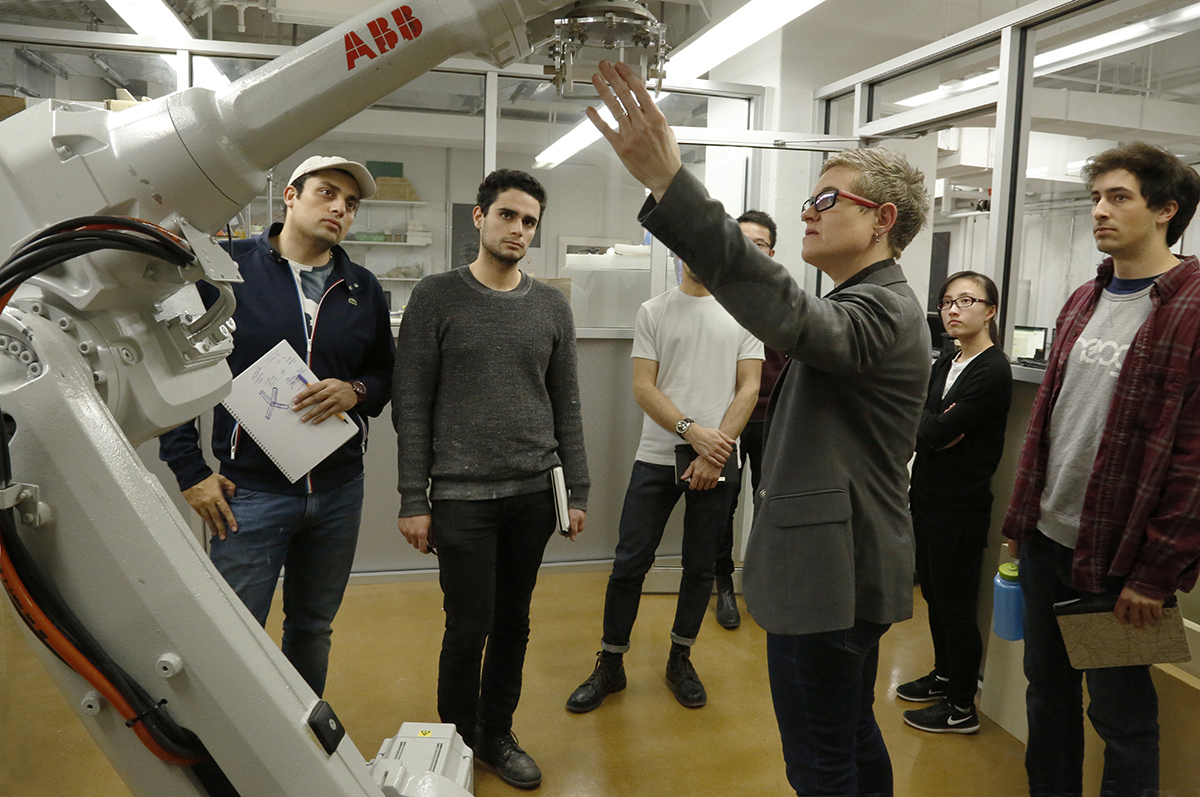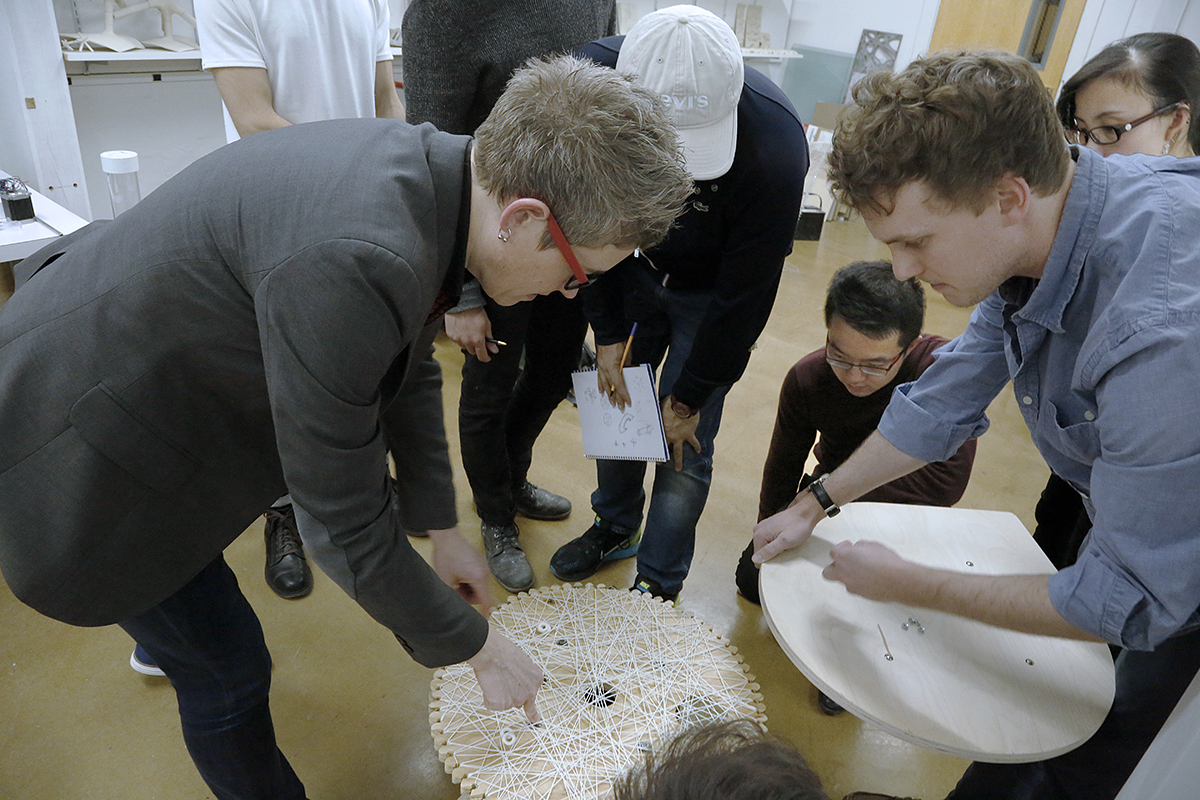Matter Design Computation grad program set to launch
By Daniel Aloi

A new collaborative research degree program, Matter Design Computation, will combine architectural research with study in the areas of material computation, adaptive architecture and digital fabrication.
Beginning this fall, the two-year program for a Cornell master’s degree in architectural science will welcome students with backgrounds in science and engineering as well as architecture. New York state approval for the program is pending.
Housed in the graduate field of architecture, the program will feature courses of study that cross disciplines, drawing on faculty from the Department of Architecture and from Biological and Environmental Engineering, Computer Science, Fiber Science & Apparel Design, Materials Science and Engineering, and Mechanical and Aerospace Engineering.
Specific subtopics within these broad disciplinary categories include bio-inspired design, biomimicry, sustainability, ecological architecture, computational design, experimental structures and applications of materials science, said Jenny Sabin, who crafted and is spearheading the program. She is the Arthur L. and Isabel B. Wiesenberger Assistant Professor in Design and Emerging Technologies in the Department of Architecture, and director of graduate studies in architecture in the College of Architecture, Art and Planning.
“We are experiencing a big paradigm shift where architects have the ability to communicate directly with digital fabrication machines, whether it’s robotic fabrication or 3-D printing,” Sabin said. “Now we can write scripts for a new type of material assembly and form, where a designer becomes a collaborator with, say, a robot. Material constraints and changes in geometry and pattern all become integrated into this design scenario, which I find really exciting.”
“The spirit of the program is to prepare advanced architectural research degree students for this paradigm shift,” she said. “It’s not a professional degree program; we are not requiring that they have an advanced degree in architecture, but we’re opening it up so that hopefully students in biology and in materials science will come and bring to it a different set of skills and questions.”
The curriculum “is purposely flexible,” she said. “During the first year, students take coursework that builds up a foundation for their thesis project.”
The degree program will enroll from four to six students in its first two or three years, Sabin said. Her goal is “to start small, to make sure students are fully funded and get a step up,” referring to support from research and/or teaching assistantships, tuition scholarships and awards. Sabin has secured funding from Autodesk to help support the program’s first enrolled student, Jingyang (Leo) Liu, M.Arch. II ’15.

“Digital technology enables designers nowadays to act more like makers, or creators, by translating their expertise in space organization and geometric manipulation directly into craft,” said Liu, a research associate in the Sabin Design Lab and a teaching associate for Sabin’s option studio in digital ceramics. “The programming language is not only the way we talk to a machine but also a protocol for people from different backgrounds to communicate.”
Liu said the new M.S. program is “an opportunity to observe and rethink about design ... from a new perspective, to develop a systematic research method and learn necessary multidisciplinary research skills.” The ability to choose courses and advisers tailored to his research is also a plus, he said.
Sabin used her lab, which includes student research associates from architecture, computer science, materials science and mechanical engineering, as a model for the new program’s cross-disciplinary inquiry.
“The dialogue on the projects has been amazing,” she said. “One of the students has been working on innovating devices that go on the end of a robot’s arm to use for digital fabrication at the architectural scale. The insight an engineer brings to these problems is transformative.”
Having someone like Liu as a TA also “brings a level of expertise in computation and digital fabrication that is incredibly important to the education of students in our professional [architecture] degree programs,” Sabin said. The new program “may appear to be small, but it has high impact on all our other programs.”
In conjunction with the program’s launch, a symposium, “Matter Design Computation: The Art of Building From Nano to Macro,” will convene March 10-11 in Milstein Auditorium. The symposium, part of the Preston H. Thomas Memorial Lecture Series, features leaders in this emerging field, with insights and theories from biology, engineering and mathematics applied to the design, fabrication and production of material structures. It is open to the public.
Architect Matthias Kohler and architectural theorist Mario Carpo are the keynote speakers. Presenters from Cornell include Sabin; Keith Evan Green, professor of design and environmental analysis and mechanical and aerospace engineering (MAE); Guy Hoffman, assistant professor of MAE; Dan Luo, professor of biological and environmental engineering; Paul McEuen, the John A. Newman Professor of Physical Science; Anil Netravali, the Jean and Douglas McLean Professor in Fiber Science & Apparel Design; Rob Shepherd, assistant professor of MAE; and Sasa Zivkovic, assistant professor of architecture.
Media Contact
Get Cornell news delivered right to your inbox.
Subscribe